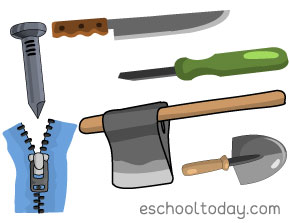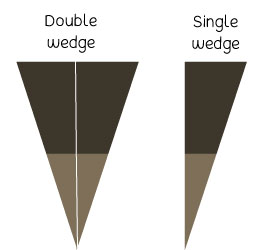- Simple Machines
What is a wedge?

A wedge is simply a triangular tool, often made of metal, wood, stone, or plastic. It is thick on one end and tapers to a thin or sharp edge on the other end. Technically it is an inclined plane (or two inclined planes put together to form a triangle) that moves. A wedge may be attached to a handle to make it easier to use. Good examples of wedges are nails, knives, axes, and your teeth!
A wedge can be used in many ways:
- To cut (knife)
- To split (axe)
- To tighten and to hold back (doorstopper)
- To hold together (nail)
- To scrape (blades on the snowplow or farm grader)
Wedges work by changing direction and force applied to it.
Here is an illustration: A diagram of change in direction and force.
 From the above, you will notice that the force applied to the thick end of the wedge overcomes the resistance of the wood. The force is directed downwards, but the wedge directs the force sideways as it drives into the wood.
From the above, you will notice that the force applied to the thick end of the wedge overcomes the resistance of the wood. The force is directed downwards, but the wedge directs the force sideways as it drives into the wood.

A wedge may be a single wedge or a double wedge. Each does a slightly different job. An axe is a double wedge (see diagram above) and a chisel is a single wedge.
Trade-off
The longer and thinner a wedge is (sharper), the more work it does with little effort. If the wedge is shorter and has a wider angle at the tip, one needs more force to do the work.
The mechanical advantage of a wedge is higher when the wedge is longer with a thinner tip.
Wedges have been in use for millions of years. Earlier humans used wedges made of hard rocks and stones to hunt (like spears), cut and trim trees, and carve stones. The concept of wedges is also used in jets and modern cars. You will notice that jets, fast cars, speed boats, and trains have pointed noses. That helps them cut through the air (air acts as a resistance). This feature of pointed noses cutting through air is known as aerodynamics.
